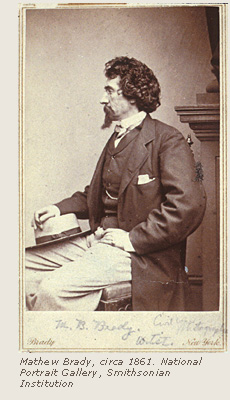|
|
|
|
|
  n
1861, at the time of Abraham Lincoln’s first inaugural on March 4, photographer
Mathew Brady was at the peak of his long and productive career. His handsomely
appointed galleries in New York and Washington attracted a steady stream of customers—from
American Presidents to foreign dignitaries—who came to have their own portraits
expertly made by one of Brady’s highly skilled operators and to view at their
leisure the hundreds of photographs of prominent personalities that adorned Brady’s
gallery walls. While many photographic studios of the period attracted patrons
by displaying portraits of the famous, Brady’s collection was indisputably
the largest and most comprehensive. Representing nearly every significant figure
in American life since the dawn of photography, it included not only politicians
and military heroes, but religious leaders, writers, artists, entertainers, and
eminent foreign visitors—any personality of interest to the public. But beyond
its use as a publicity tool, Mathew Brady’s distinguished collection served
to manifest his own sense of historical mission as well. “From the very first,”
Brady told an interviewer in 1891, “I regarded myself as under obligation
to my country to preserve the faces of its historic men and mothers.” n
1861, at the time of Abraham Lincoln’s first inaugural on March 4, photographer
Mathew Brady was at the peak of his long and productive career. His handsomely
appointed galleries in New York and Washington attracted a steady stream of customers—from
American Presidents to foreign dignitaries—who came to have their own portraits
expertly made by one of Brady’s highly skilled operators and to view at their
leisure the hundreds of photographs of prominent personalities that adorned Brady’s
gallery walls. While many photographic studios of the period attracted patrons
by displaying portraits of the famous, Brady’s collection was indisputably
the largest and most comprehensive. Representing nearly every significant figure
in American life since the dawn of photography, it included not only politicians
and military heroes, but religious leaders, writers, artists, entertainers, and
eminent foreign visitors—any personality of interest to the public. But beyond
its use as a publicity tool, Mathew Brady’s distinguished collection served
to manifest his own sense of historical mission as well. “From the very first,”
Brady told an interviewer in 1891, “I regarded myself as under obligation
to my country to preserve the faces of its historic men and mothers.”
In 1981, with the assistance of the United States Congress, the National Portrait
Gallery purchased a group of more than 5,400 original Mathew Brady collodion wet-plate glass negatives from the legendary collection originally assembled by Frederick
Hill Meserve. The portrait images displayed here and organized by Ann Shumard, NPG's curator of photographs, are modern albumen silver prints made
from selected Brady negatives in the Gallery's Meserve Collection.
|
|
|

